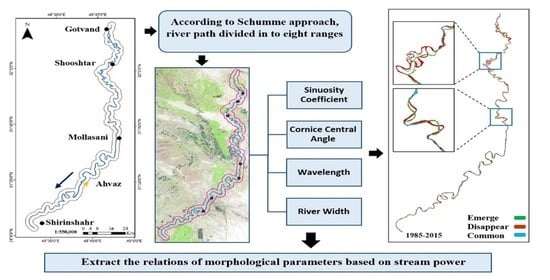Spatiotemporal Characterization and Analysis of River Morphology Using Long-Term Landsat Imagery and Stream Power
Abstract
:1. Introduction
2. Material and Method
2.1. Study Area and Data
2.2. Data
2.3. Methods
3. Results
3.1. Schumm Approach for Channel Pattern
3.2. Sinuosity Coefficient
3.3. Cornice Central Angle
3.4. River Width
3.5. Stream Power
3.6. River Migration
3.7. Influence of Gotvand Dam on the Karun River Morphological Pattern
4. Discussion
4.1. Influence of Human Activities on the River Morphology
4.2. Morphological Pattern
5. Conclusions
Author Contributions
Funding
Institutional Review Board Statement
Informed Consent Statement
Data Availability Statement
Conflicts of Interest
Appendix A
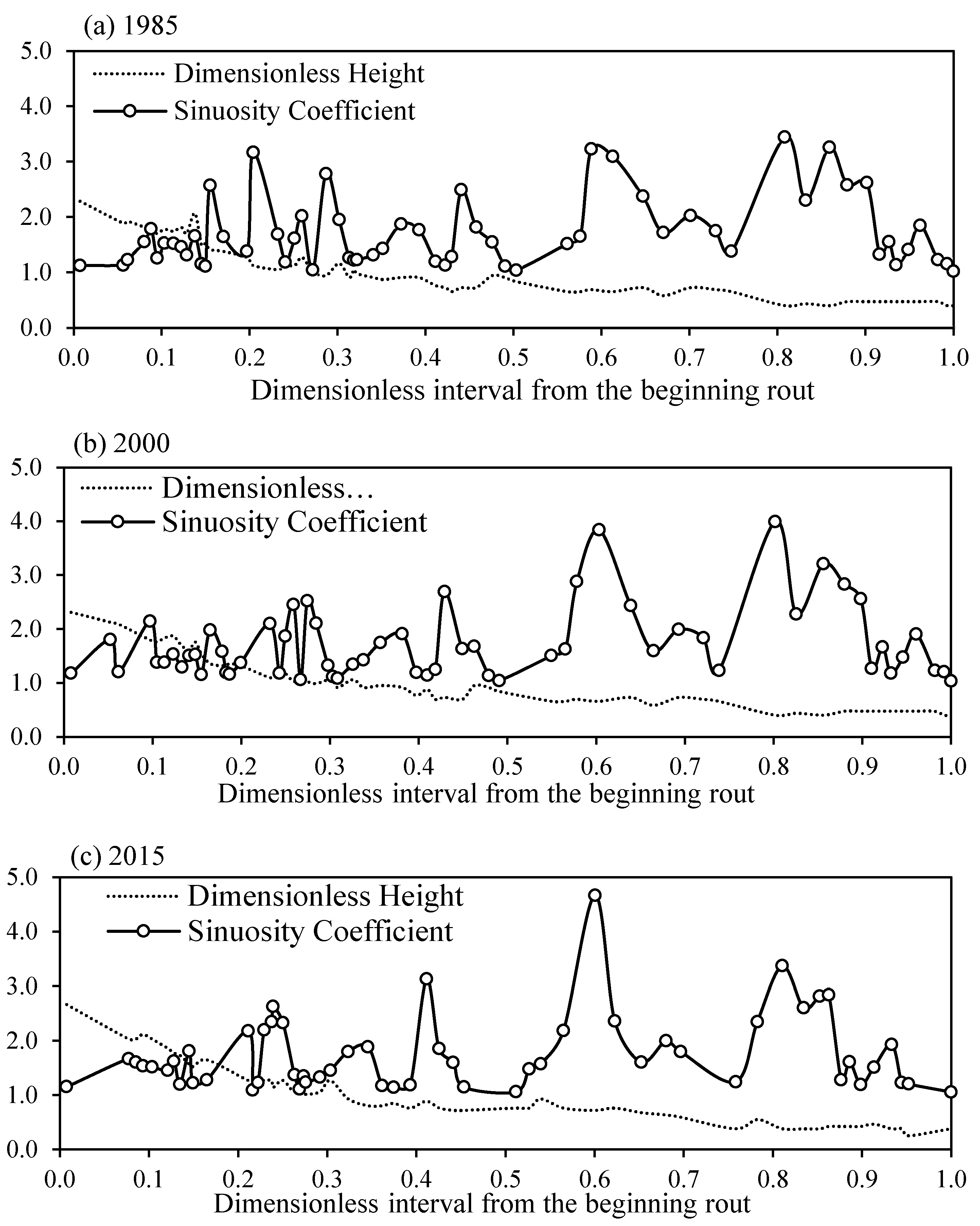
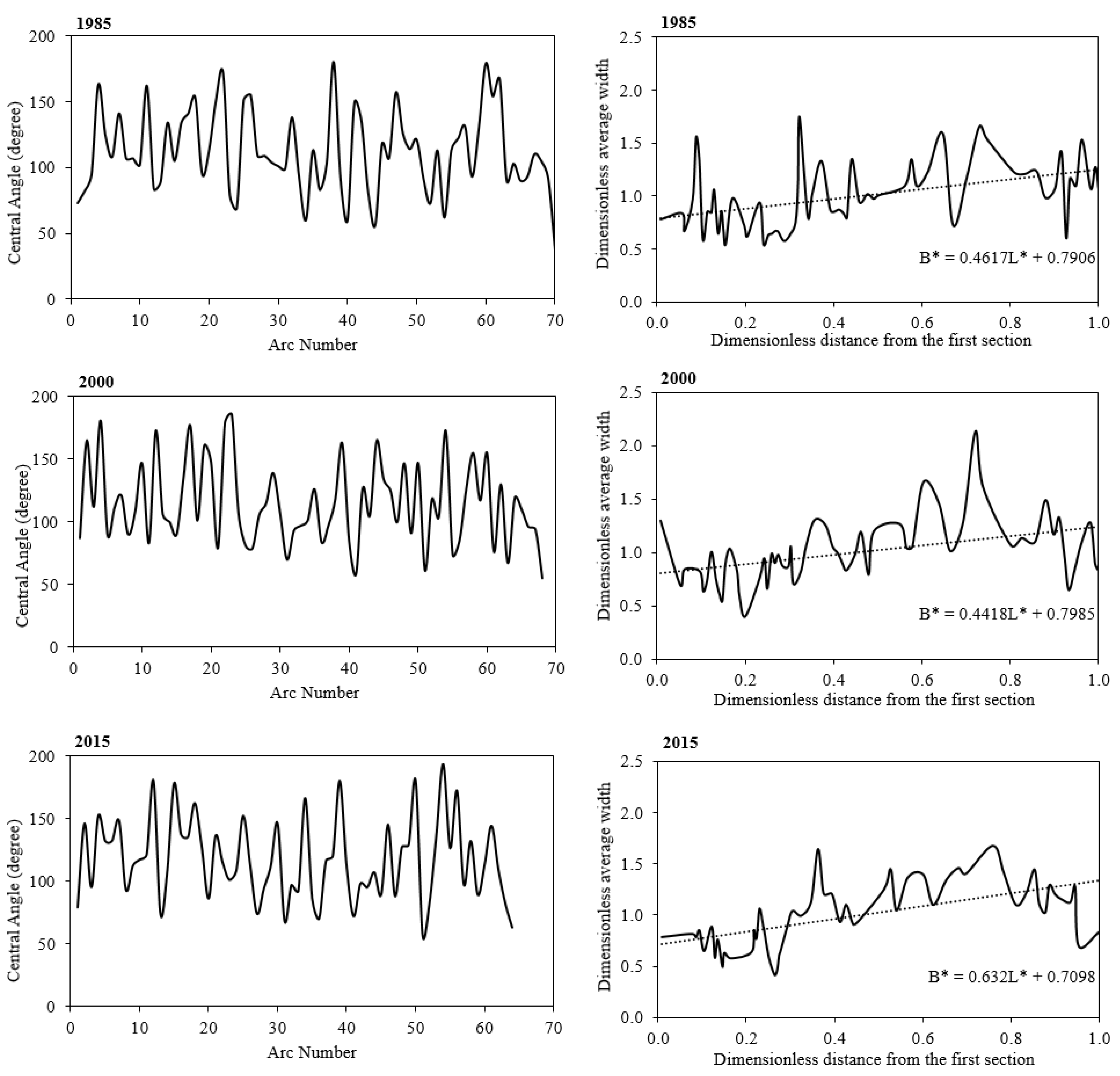
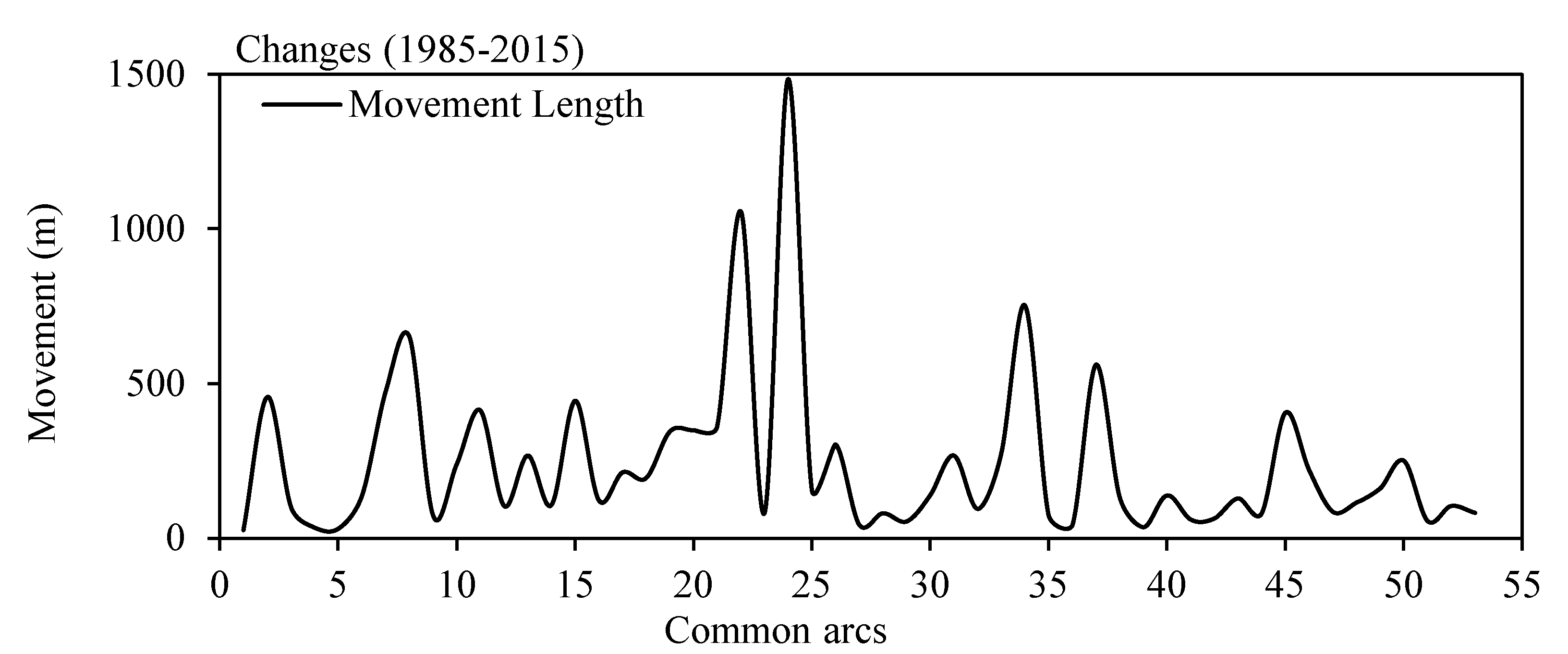
References
- Crosato, A. Analysis and Modelling of River Meandering—Analyse En Modellering van Meanderende Rivieren; IOS Press: Amsterdam, The Netherlands, 2008. [Google Scholar]
- Muhar, S.; Jungwirth, M.; Unfer, G.; Wiesner, C.; Poppe, M.; Schmutz, S.; Hohensinner, S.; Habersack, H. 30 Restoring Riverine Landscapes at the Drau River: Successes and Deficits in the Context of Ecological Integrity. Dev. Earth Surf. Process. 2007, 11, 779–803. [Google Scholar] [CrossRef]
- Rapp, C.F.; Abbe, T.B. A Framework for Delineating Channel Migration Zones; 03-06-027, Washington State Departments of Ecology and Transportation: Lacey, WA, USA, 2003. [Google Scholar]
- Sarker, S.; Veremyev, A.; Boginski, V.; Singh, A. Critical Nodes in River Networks. Sci. Rep. 2019, 9, 11178. [Google Scholar] [CrossRef] [Green Version]
- Lagasse, P.; Zevenbergen, L.; Spitz, W.; Thorne, C. Methodology for Predicting Channel Migration. Available online: https://nap.nationalacademies.org/read/23352/chapter/1 (accessed on 5 December 2021).
- Perucca, E.; Camporeale, C.; Ridolfi, L. Influence of River Meandering Dynamics on Riparian Vegetation Pattern Formation. J. Geophys. Res. Biogeosci. 2006, 111. [Google Scholar] [CrossRef] [Green Version]
- Kong, D.; Latrubesse, E.M.; Miao, C.; Zhou, R. Morphological Response of the Lower Yellow River to the Operation of Xiaolangdi Dam, China. Geomorphology 2020, 350, 106931. [Google Scholar] [CrossRef]
- Lofthouse, C.; Robert, A. Riffle-Pool Sequences and Meander Morphology. Geomorphology 2008, 99, 214–223. [Google Scholar] [CrossRef]
- Camporeale, C.; Hydrology, L.R. Interplay among River Meandering, Discharge Stochasticity and Riparian Vegetation. J. Hydrol. 2010, 382, 138–144. [Google Scholar] [CrossRef]
- Ghimire, S.; Higaki, D. Dynamic River Morphology Due to Land Use Change and Erosion Mitigation Measures in a Degrading Catchment in the Siwalik Hills, Nepal. Int. J. River Basin Manag. 2015, 13, 27–39. [Google Scholar] [CrossRef]
- Morianou, G.G.; Kourgialas, N.N.; Karatzas, G.P.; Nikolaidis, N.P. Assessing Hydro-Morphological Changes in Mediterranean Stream Using Curvilinear Grid Modeling Approach—Climate Change Impacts. Earth Sci. Inform. 2017, 11, 205–216. [Google Scholar] [CrossRef]
- Arróspide, F.; Mao, L.; Escauriaza, C. Morphological Evolution of the Maipo River in Central Chile: Influence of Instream Gravel Mining. Geomorphology 2018, 306, 182–197. [Google Scholar] [CrossRef]
- Bregoli, F.; Crosato, A.; Paron, P.; McClain, M.E. Humans Reshape Wetlands: Unveiling the Last 100 years of Morphological Changes of the Mara Wetland, Tanzania. Sci. Total Environ. 2019, 691, 896–907. [Google Scholar] [CrossRef]
- Yousefi, S.; Moradi, H.R.; Keesstra, S.; Pourghasemi, H.R.; Navratil, O.; Hooke, J. Effects of Urbanization on River Morphology of the Talar River, Mazandarn Province, Iran. Geocarto Int. 2019, 34, 276–292. [Google Scholar] [CrossRef]
- Fernandes, M.R.; Aguiar, F.C.; Martins, M.J.; Rivaes, R.; Ferreira, M.T. Long-Term Human-Generated Alterations of Tagus River: Effects of Hydrological Regulation and Land-Use Changes in Distinct River Zones. Catena 2020, 188, 104466. [Google Scholar] [CrossRef]
- Das, T.K.; Haldar, S.K.; Das Gupta, I.; Sen, S. River Bank Erosion Induced Human Displacement and Its Consequences. Living Rev. Landsc. Res. 2014, 8, 3. [Google Scholar] [CrossRef] [Green Version]
- Gordon, E.; Meentemeyer, R.K. Effects of Dam Operation and Land Use on Stream Channel Morphology and Riparian Vegetation. Geomorphology 2006, 82, 412–429. [Google Scholar] [CrossRef]
- Rutherfurd, I.; Price, P. Management on Stream Erosion. Influ. Riparian Manag. Stream Eros. 2007, 86–116. [Google Scholar]
- Liu, Y.; Qiao, Y.; Zhong, Y. Dynamic Monitoring and Driving Force Analysis on Rivers and Lakes in Zhuhai City Using Remote Sensing Technologies. Procedia Environ. Sci. 2011, 10, 2677–2683. [Google Scholar] [CrossRef] [Green Version]
- Yousefi, S.; Khatami, R.; Mountrakis, G.; Mirzaee, S.; Pourghasemi, H.R.; Tazeh, M. Accuracy Assessment of Land Cover/Land Use Classifiers in Dry and Humid Areas of Iran. Environ. Monit. Assess. 2015, 187, 641. [Google Scholar] [CrossRef]
- Sarker, S.; Sarker, T.; Raihan, S.U. Comprehensive Understanding of the Planform Complexity of the Anastomosing River and the Dynamic Imprint of the River’s Flow: Brahmaputra River in Bangladesh. Earth Sci. India 2022, preprint. [Google Scholar] [CrossRef]
- Pal, S. Impact of Massanjore Dam on Hydro-Geomorphological Modification of Mayurakshi River, Eastern India. Environ. Dev. Sustain. 2016, 18, 921–944. [Google Scholar] [CrossRef]
- Han, J.; Zhang, W.; Fan, Y.; Yu, M. Interacting Effects of Multiple Factors on the Morphological Evolution of the Meandering Reaches Downstream the Three Gorges Dam. J. Geogr. Sci. 2017, 27, 1268–1278. [Google Scholar] [CrossRef] [Green Version]
- Reisenbüchler, M.; Bui, M.D.; Skublics, D.; Rutschmann, P. An Integrated Approach for Investigating the Correlation between Floods and River Morphology: A Case Study of the Saalach River, Germany. Sci. Total Environ. 2019, 647, 814–826. [Google Scholar] [CrossRef] [PubMed]
- Can, M.; Çalışır, E.; Akpınar, A.; Doğan, E. The Effects of the Dam Construction Process on Downstream River Geomorphology. Arab. J. Geosci. 2021, 14, 2122. [Google Scholar] [CrossRef]
- Sarasekanrood, S.A.; Madadi, A.; Bashokouh, Z.; Ghaleh, E.; Sciences, H.; Sciences, H. Investigating the Pattern and Dynamics of Gharasu River in Ardabil (From Samian Bridge to Sabalan Dam). Hydrogeomorphology 2021, 8, 2019–2022. [Google Scholar]
- Khaleghi, S.; Sadough, S.H.; Khodayari, M. Assessment of Morphological Changes of Taleghan River in Upstream of Taleghan Dam. Sustain. Earth Rev. 2020, 1, 38–45. [Google Scholar] [CrossRef]
- Sarker, S.; Sarker, S. Essence of MIKE 21C (FDM Numerical Scheme): Application on the River Morphology of Bangladesh. Open J. Model. Simul. 2022, 10, 88–117. [Google Scholar] [CrossRef]
- Lecce, S.A. Stream Power, Channel Change, and Channel Geometry in the Blue River, Wisconsin. Phys. Geogr. 2013, 34, 293–314. [Google Scholar] [CrossRef]
- Ramani, R.S.; Patel, P.L.; Timbadiya, P.V. Key Morphological Changes and Their Linkages with Stream Power and Land-Use Changes in the Upper Tapi River Basin, India. Int. J. Sediment. Res. 2021, 36, 602–615. [Google Scholar] [CrossRef]
- Kleinhans, M.G.; Van Den Berg, J.H. River Channel and Bar Patterns Explained and Predicted by an Empirical and a Physics-Based Method. Earth Surf. Process. Landf. 2010, 36, 721–738. [Google Scholar] [CrossRef]
- Candel, J.; Kleinhans, M.; Makaske, B.; Wallinga, J. Predicting River Channel Pattern Based on Stream Power, Bed Material and Bank Strength. Prog. Phys. Geogr. Earth Environ. 2020, 45, 253–278. [Google Scholar] [CrossRef]
- Woolderink, H.A.G.; Cohen, K.M.; Kasse, C.; Kleinhans, M.G.; Van Balen, R.T. Patterns in River Channel Sinuosity of the Meuse, Roer and Rhine Rivers in the Lower Rhine Embayment Rift-System, Are They Tectonically Forced? Geomorphology 2021, 375, 107550. [Google Scholar] [CrossRef]
- Ollero, A. Channel Changes and Floodplain Management in the Meandering Middle Ebro River, Spain. Geomorphology 2010, 117, 247–260. [Google Scholar] [CrossRef]
- Yousefi, S.; Vfakhah, M.; Mirzaee, S.; Tavangar, S. Changes of Some Morphological Parameters of Karoon River Using Remote Sensing. Iran. Remot Sens. GIS 2013, 5, 85–96. [Google Scholar]
- Khoi, D.N.; Suetsugi, T. Impact Des Changements Climatiques et de l’utilisation Des Terres Sur Les Processus Hydrologiques et La Production de Sédiments-Étude de Cas Du Bassin Versant de La Rivière Be, Vietnam. Hydrol. Sci. J. 2014, 59, 1095–1108. [Google Scholar] [CrossRef]
- Bhuiyan, M.A.H.; Kumamoto, T.; Suzuki, S. Application of Remote Sensing and GIS for Evaluation of the Recent Morphological Characteristics of the Lower Brahmaputra-Jamuna River, Bangladesh. Earth Sci. Informatics 2014, 8, 551–568. [Google Scholar] [CrossRef]
- Aiello, A.; Adamo, M.; Canora, F. Remote Sensing and GIS to Assess Soil Erosion with RUSLE3D and USPED at River Basin Scale in Southern Italy. Catena 2015, 131, 174–185. [Google Scholar] [CrossRef]
- Clerici, A.; Perego, S.; Chelli, A.; Tellini, C. Morphological Changes of the Floodplain Reach of the Taro River (Northern Italy) in the Last Two Centuries. J. Hydrol. 2015, 527, 1106–1122. [Google Scholar] [CrossRef]
- Mitidieri, F.; Papa, M.N.; Amitrano, D.; Ruello, G. European Journal of Remote Sensing River Morphology Monitoring Using Multitemporal SAR Data: Preliminary Results. Eur. J. Remote Sens. 2017, 49, 889–898. [Google Scholar] [CrossRef]
- Hemmelder, S.; Marra, W.; Markies, H.; De Jong, S.M. Monitoring River Morphology & Bank Erosion Using UAV Imagery—A Case Study of the River Buëch, Hautes-Alpes, France. Int. J. Appl. Earth Obs. Geoinf. 2018, 73, 428–437. [Google Scholar] [CrossRef]
- Zheng, S.; Han, S.; Tan, G.; Xia, J.; Wu, B.; Wang, K.; Edmonds, D.A. Morphological Adjustment of the Qingshuigou Channel on the Yellow River Delta and Factors Controlling Its Avulsion. Catena 2018, 166, 44–55. [Google Scholar] [CrossRef]
- Nones, M. Remote Sensing and GIS Techniques to Monitor Morphological Changes along the Middle-Lower Vistula River, Poland. Int. J. River Basin Manag. 2021, 19, 345–357. [Google Scholar] [CrossRef]
- Rashidi, M.; Hoseinzade, S.R.; Sepehr, A.; Zarei, H.; Khanebad, M. The Study of Geomorphological Changes in Karun River and Its Reasons in the Period of 1954–2011(1334–1391). Quant. Geomorphol. Res. 2016, 5, 43–59. [Google Scholar]
- Arshad, S.; Morid, S.; Hadi, M. Assessing the Trend of Morphologic Changes of Rivers Using Remote Sensing (Case Study: Karun river between Gotvand and Farsiat). J. Agric. Sci. Nat. Resour. 2007, 14, 180–194. [Google Scholar]
- Xu, H. Modification of Normalised Difference Water Index (NDWI) to Enhance Open Water Features in Remotely Sensed Imagery. Int. J. Remote Sens. 2007, 27, 3025–3033. [Google Scholar] [CrossRef]
- Maghsoudi, M.; Zamanzadeh, S.M.; Yamani, M.; Hajizadeh, A.; Maghsoudi, M.; Zamanzadeh, S.M.; Yamani, M.; Hajizadeh, A. Morphometric Assessment of Meandering River in Arid Region Using Improvement Model (Case Study: Maroon River). J. Water Resour. Prot. 2017, 9, 358–377. [Google Scholar] [CrossRef] [Green Version]
- Frasson, R.P.d.M.; Pavelsky, T.M.; Fonstad, M.A.; Durand, M.T.; Allen, G.H.; Schumann, G.; Lion, C.; Beighley, R.E.; Yang, X. Global Relationships Between River Width, Slope, Catchment Area, Meander Wavelength, Sinuosity, and Discharge. Geophys. Res. Lett. 2019, 46, 3252–3262. [Google Scholar] [CrossRef]
- Leopold, A. Plant Growth and Development; McGraw-Hill Book Co.: New York, NY, USA, 1964. [Google Scholar]
- Morisawa, M. Rivers: Form and Process; Clayton, K., Ed.; Longman: London, UK; New York, NY, USA, 1985. [Google Scholar]
- Selby, M.J. Earth’s Changing Surface: An Introduction to Geomorphology; Oxford University Press: Oxford, UK, 1985. [Google Scholar]
- Brierley, G.; Fryirs, K. Geomorphology and River Management: Applications of the River Styles Framework; Wiley-Blackwell: Hoboken, NJ, USA, 2005. [Google Scholar]
- Schumm, S.A. Patterns of Alluvial Rivers. Annu. Rev. Earth Planet. Sci. 1985, 13, 5–27. [Google Scholar] [CrossRef]
- Mengen, D.; Ottinger, M.; Leinenkugel, P.; Ribbe, L. Modeling River Discharge Using Automated River Width Measurements Derived from Sentinel-1 Time Series. Remote Sens. 2020, 12, 3236. [Google Scholar] [CrossRef]
- Byishimo, P.; Vargas-Luna, A.; Crosato, A. Effects of Variable Discharge on the River Channel Width Variation. Available online: https://www.researchgate.net/publication/275339519_Effects_of_variable_discharge_on_the_river_channel_width_variation (accessed on 5 December 2021).
- Wang, P.; Fu, K.; Huang, J.; Duan, X.; Yang, Z. Morphological Changes in the Lower Lancang River Due to Extensive Human Activities. PeerJ 2020, 8, e9471. [Google Scholar] [CrossRef]
- Timár, G. Controls on Channel Sinuosity Changes: A Case Study of the Tisza River, the Great Hungarian Plain. Quat. Sci. Rev. 2003, 22, 2199–2207. [Google Scholar] [CrossRef] [Green Version]
- Petrovszki, J. Is Sinuosity a Function of Slope and Bankfull Discharge? —A Case Study of the Meandering Rivers in the Pannonian Basin. Hydrol. Earth Syst. Sci. Discuss. 2014, 11, 12271–12290. [Google Scholar] [CrossRef] [Green Version]
- Nelson, N.C.; Erwin, S.O.; Schmidt, J.C. Spatial and Temporal Patterns in Channel Change on the Snake River Downstream from Jackson Lake Dam, Wyoming. Geomorphology 2013, 200, 132–142. [Google Scholar] [CrossRef]
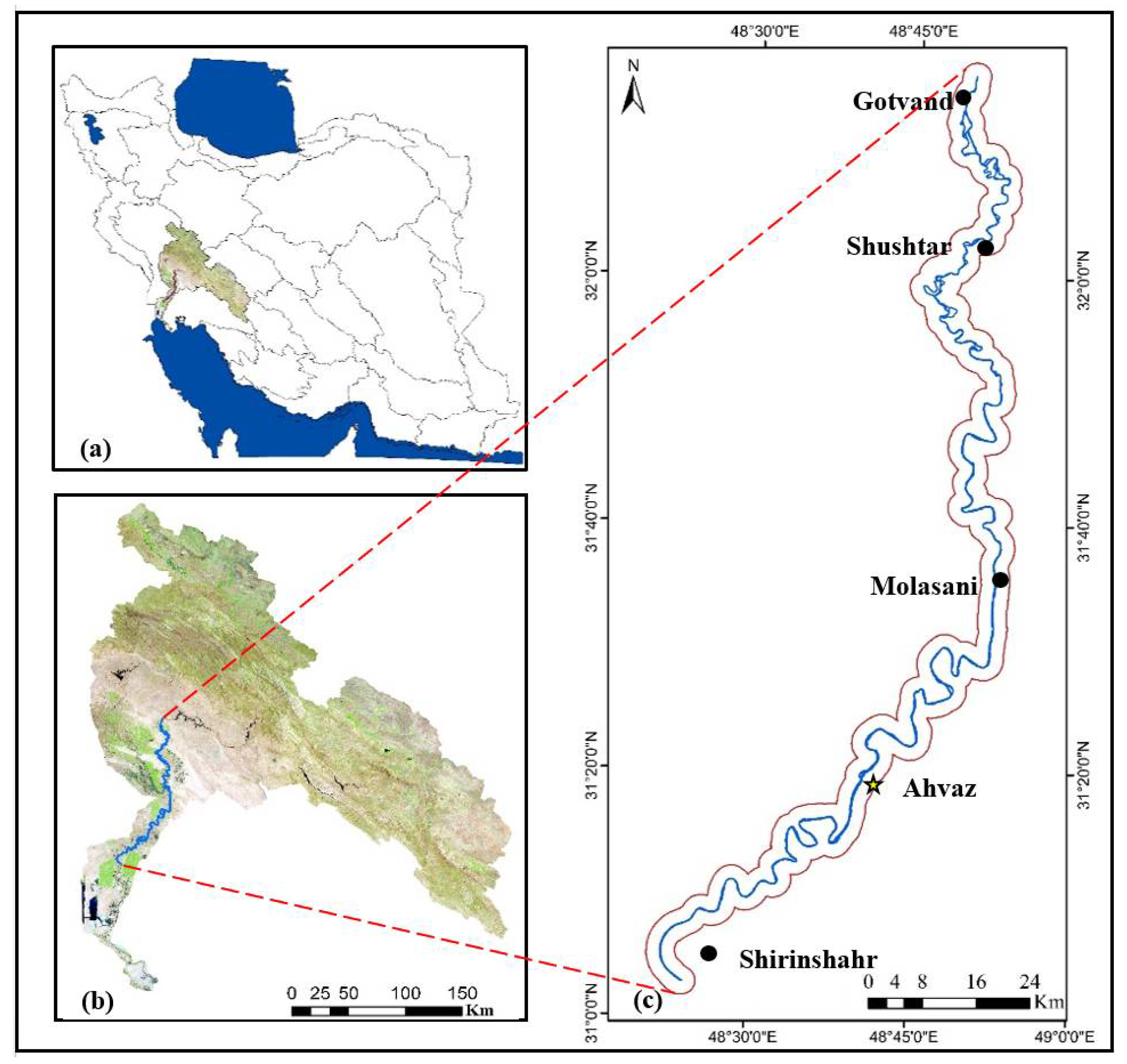
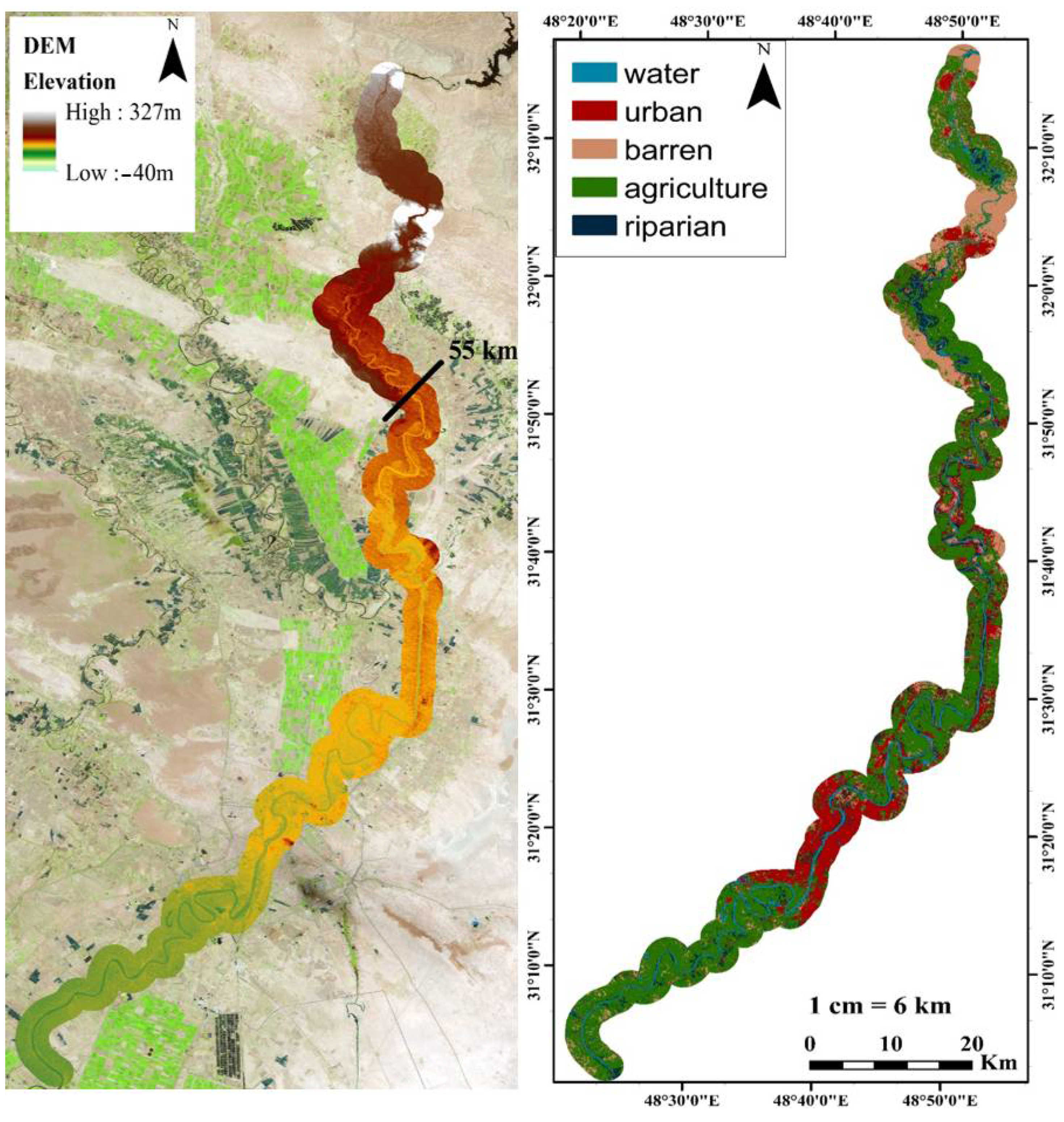
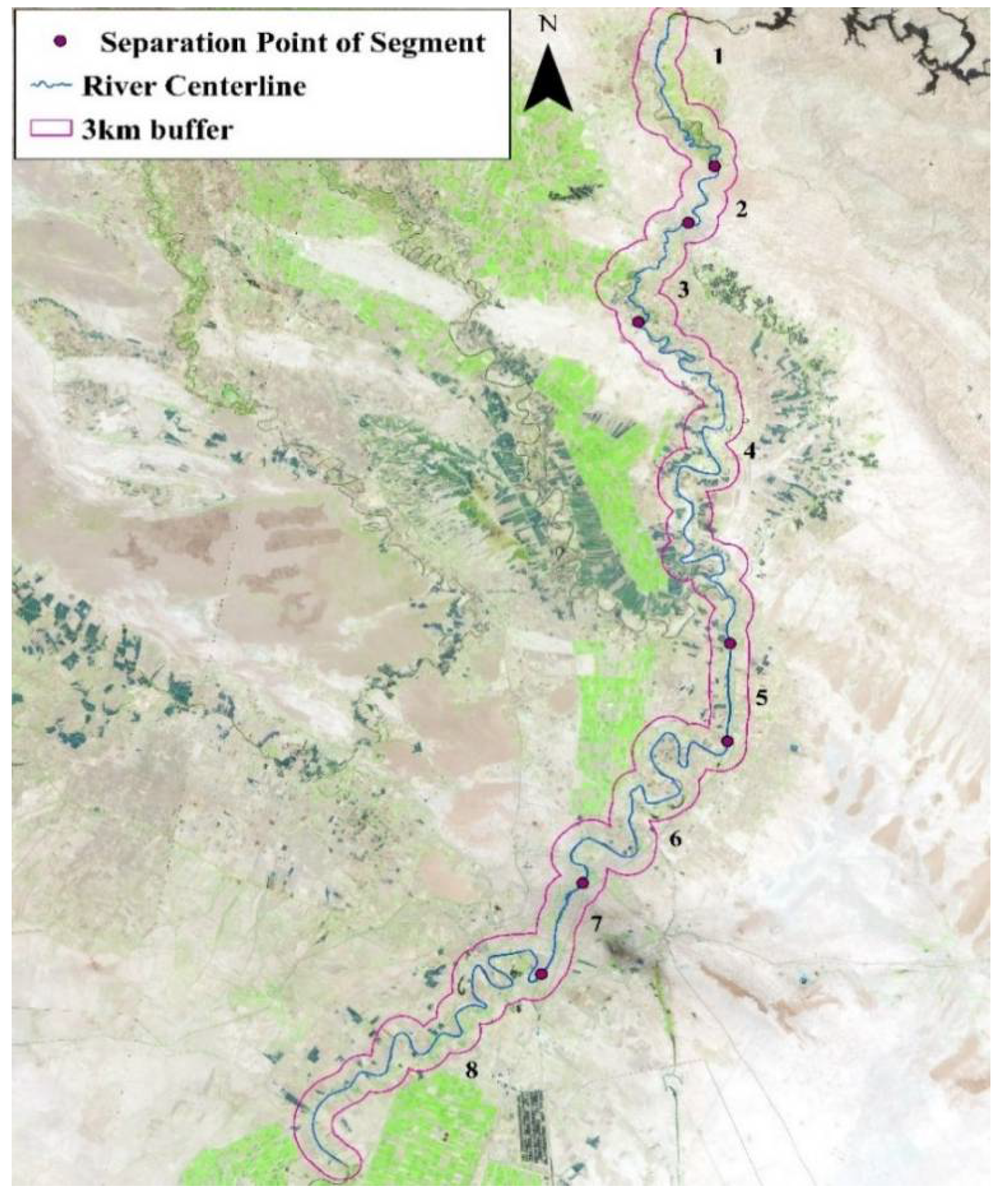
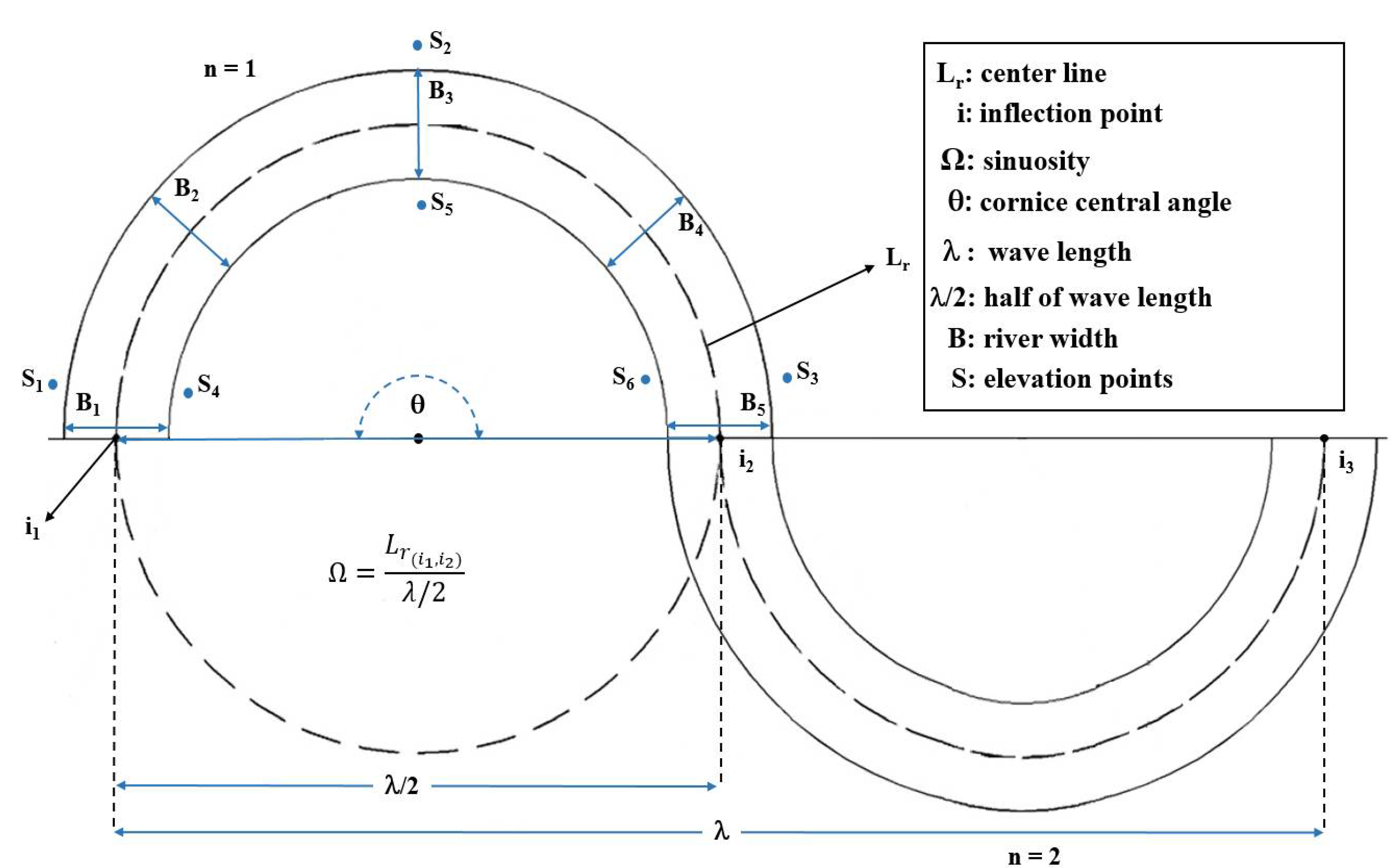

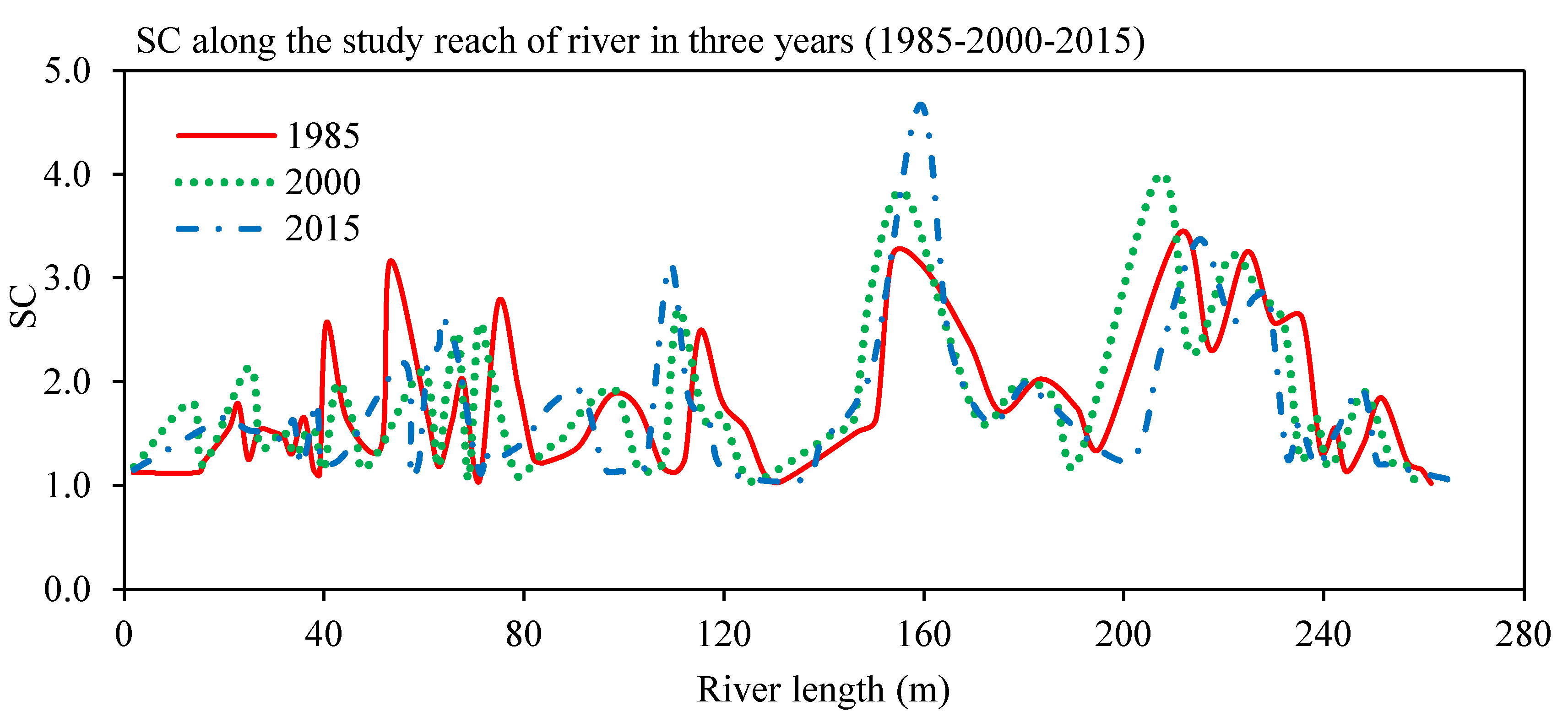

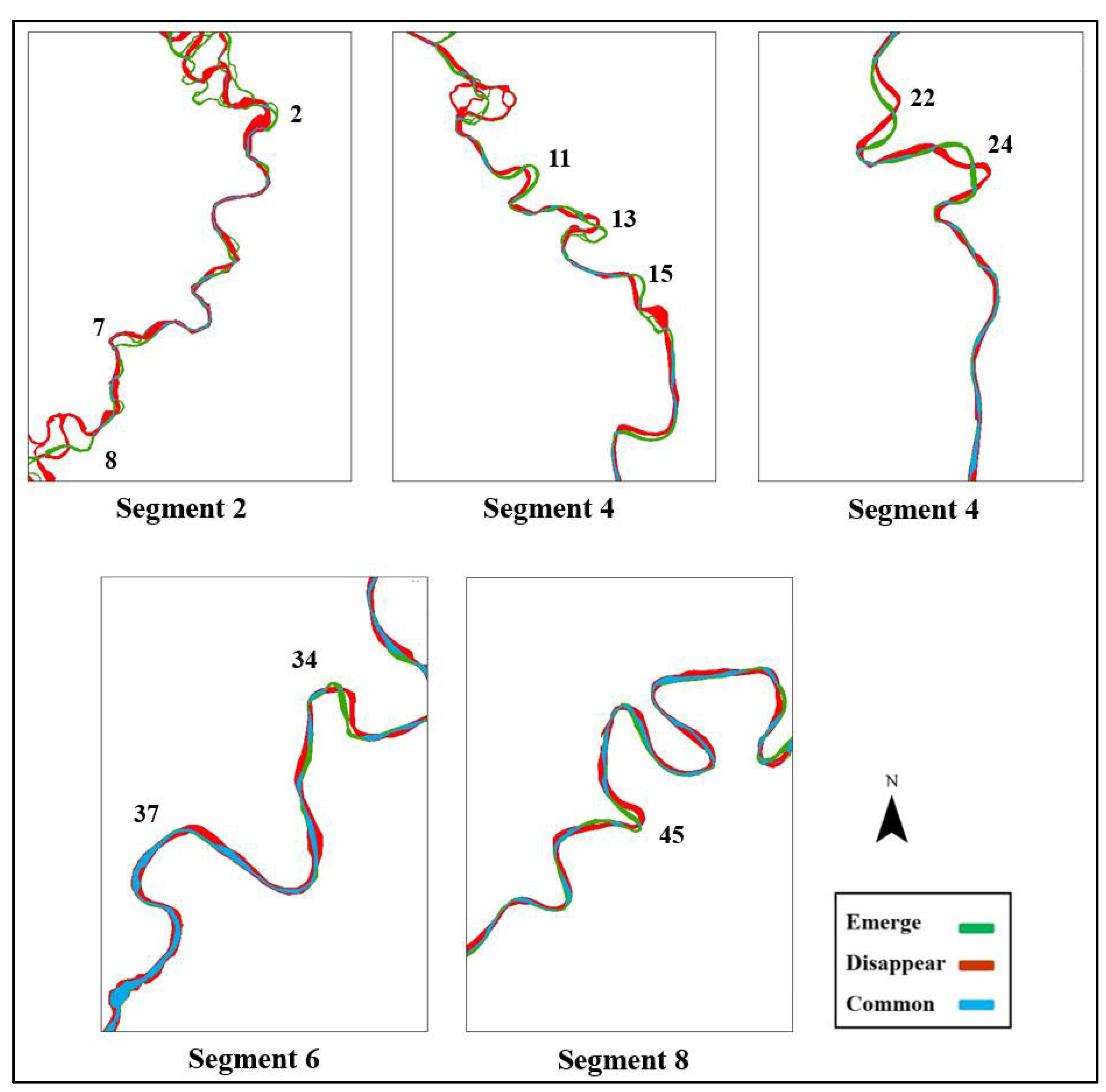
| Sub-Basin Name | Sub-Basin Code | Area (km2) | Number of Fourth-Grade Sub-Basins | Main River | ||
|---|---|---|---|---|---|---|
| Mountain | Plain | Total | ||||
| Karun | 231 | 31,657.0 | 9538.7 | 41,195.7 | 30 | Karun |
| Dez | 232 | 14,893.1 | 5112.4 | 20,005.5 | 9 | Dez |
| Karun downstream | 233 | 28.5 | 5882.7 | 5911.2 | 3 | Karun downstream |
| Great Karun basin | 23 | 46,578.5 | 20,533.8 | 67,112.3 | 42 | Great Karun |
| Satellite | Sensor | Resolution (m2) | Date |
|---|---|---|---|
| Landsat-4 | TM | 30 * 30 | 5 May 1985 |
| Landsat-5 | TM | 30 * 30 | 30 May 2000 |
| Landsat-8 | ETM+ | 30 * 30 | 30 May 2015 |
| SRTM | 30 * 30 | 30 June 2018 |
| Interval | Branches | Sinuosity Coefficient | Lateral Stability | Other Morphological Changes |
|---|---|---|---|---|
| 1 | Anabranch or Anastomosing | - | Arc rotation | Some arteries disappear—reduce width |
| 2 | Single-channel | Regular meander | Reduce width—meander neck displacement | |
| 3 | Wandering | - | Main line change | Reduce width—some arteries disappear |
| Anabranch or Anastomosing | - | Thalweg change | ||
| 4 | Single-channel | Translation to downstream—neck and chute cutoff—increasing arc domain | Reduce width | |
| Wandering | ||||
| 5 | Single-channel | Straight | Reduce width | |
| 6 | Single-channel | Translation to downstream | Reduce width | |
| 7 | Single-channel | Straight | Reduce width | |
| Wandering | Reduce width | |||
| 8 | Single-channel | Translation to downstream | Reduce width | |
| Wandering |
| Interval | Meandering | |||||
|---|---|---|---|---|---|---|
| Extension | Translation | Rotation | Conversion | Neck Cutoff | Chute Cutoffs | |
 | ||||||
| 1 | Braiding | |||||
| 2 | * | |||||
| 3 | ||||||
| 4 | * | * | * | * | ||
| 5 | Straight | |||||
| 6 | * | |||||
| Straight | ||||||
| 8 | * | * | ||||
| Interval | Braided | ||||
|---|---|---|---|---|---|
| Sinuous Side Channels Mainly | Cutoff Loops Mainly | Split Channel, Sinuous Anabranches | Split Channel, Sub-parallel Anabranches | Composite | |
 | |||||
| 1 | * | * | |||
| 2 | Meandering | ||||
| 3 | * | * | |||
| 4 | Meandering | ||||
| 5 | Straight | ||||
| 6 | Meandering | ||||
| 7 | Straight | ||||
| 8 | Meandering | ||||
| Sinuosity Coefficient | 1985 | 2000 | 2015 |
|---|---|---|---|
| Mean | 1.7 | 1.72 | 1.77 |
| Max | 3.44 | 3.99 | 4.67 |
| Min | 1.02 | 1.04 | 1.06 |
| Arc SC Index | 1985 | 2000 | 2015 | |||||||
|---|---|---|---|---|---|---|---|---|---|---|
| Number of Arcs | Arc Length (m) | Arc Length (%) | Number of Arcs | Arc Length (m) | Arc Length (%) | Number of Arcs | Arc Length (m) | Arc Length (%) | ||
| Straight | <1.05 | 3 | 6543 | 3.14 | 2 | 5095 | 2.5 | - | - | - |
| Sinuous | 1.06–1.3 | 17 | 35,024 | 16.79 | 19 | 42,848 | 21.01 | 19 | 42,171 | 21.56 |
| Meander | >1.3 | 41 | 167,075 | 80.08 | 39 | 155,982 | 76.94 | 38 | 153,444 | 78.44 |
| Total | 61 | 208,642 | 100 | 60 | 203,925 | 100 | 57 | 195,615 | 100 | |
| River Shape | Arc Central Angle (Degree) | Percentage | ||
|---|---|---|---|---|
| 1985 | 2000 | 2015 | ||
| Straight river | - | - | - | - |
| Semi-meandering river | 0–41 | 1.4 | 0 | 0 |
| Undeveloped meandering river | 41–85 | 20 | 17.6 | 15.6 |
| Developed meandering river | 85–158 | 70 | 73.5 | 75 |
| More developed meander-like river | 158–296 | 8.6 | 8.8 | 9.4 |
| River oxbow | >296 | 0 | 0 | 0 |
| i | Years | 1985 | 2000 | 2015 | 1985–2015 | |||
|---|---|---|---|---|---|---|---|---|
| ηi | ki | R2 | ki | R2 | ki | R2 | ki | |
| 1 | Width, B | 1.04 | 0.9792 | 0.9963 | 0.9915 | 1.0314 | 0.9535 | 0.9965 |
| 2 | Wave Length, WL | 0.9713 | 0.9962 | 0.9387 | 0.9915 | 0.9752 | 0.9945 | 0.9561 |
| 3 | Cornice Central Angle, CA | 1.0815 | 0.9477 | 1.048 | 0.9591 | 1.0628 | 0.889 | 0.9717 |
| 4 | Sinuosity, Sin | 1.0045 | 0.9884 | 0.9762 | 0.9962 | 0.9898 | 0.9851 | 0.9801 |
| Time Interval | Relation Type | Width Changes (%) | Sinuosity Changes (%) | Cornice Changes (%) |
|---|---|---|---|---|
| 1985–2000 | Positive | 26.42 | 56.6 | 52.83 |
| Negative | 73.58 | 35.85 | 41.51 | |
| Zero | 0 | 7.55 | 5.66 | |
| 2000–2015 | Positive | 22.64 | 56.6 | 62.26 |
| Negative | 77.36 | 35.85 | 37.74 | |
| Zero | 0 | 7.55 | 0 |
Publisher’s Note: MDPI stays neutral with regard to jurisdictional claims in published maps and institutional affiliations. |
© 2022 by the authors. Licensee MDPI, Basel, Switzerland. This article is an open access article distributed under the terms and conditions of the Creative Commons Attribution (CC BY) license (https://creativecommons.org/licenses/by/4.0/).
Share and Cite
Arfa-Fathollahkhani, A.; Ayyoubzadeh, S.A.; Shafizadeh-Moghadam, H.; Mianabadi, H. Spatiotemporal Characterization and Analysis of River Morphology Using Long-Term Landsat Imagery and Stream Power. Water 2022, 14, 3656. https://doi.org/10.3390/w14223656
Arfa-Fathollahkhani A, Ayyoubzadeh SA, Shafizadeh-Moghadam H, Mianabadi H. Spatiotemporal Characterization and Analysis of River Morphology Using Long-Term Landsat Imagery and Stream Power. Water. 2022; 14(22):3656. https://doi.org/10.3390/w14223656
Chicago/Turabian StyleArfa-Fathollahkhani, Atefe, Seyed Ali Ayyoubzadeh, Hossein Shafizadeh-Moghadam, and Hojjat Mianabadi. 2022. "Spatiotemporal Characterization and Analysis of River Morphology Using Long-Term Landsat Imagery and Stream Power" Water 14, no. 22: 3656. https://doi.org/10.3390/w14223656
APA StyleArfa-Fathollahkhani, A., Ayyoubzadeh, S. A., Shafizadeh-Moghadam, H., & Mianabadi, H. (2022). Spatiotemporal Characterization and Analysis of River Morphology Using Long-Term Landsat Imagery and Stream Power. Water, 14(22), 3656. https://doi.org/10.3390/w14223656




